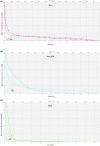New fractionations in breast cancer: a dosimetric study of 3D-CRT versus VMAT
- PMID: 34551211
- PMCID: PMC9163458
- DOI: 10.1002/jmrs.530
New fractionations in breast cancer: a dosimetric study of 3D-CRT versus VMAT
Abstract
Introduction: Adjuvant radiation therapy (RT) following primary surgery in women affected by early breast cancer (EBC) plays a central role in reducing local recurrences and overall mortality. The FAST-FORWARD trial recently demonstrated that 1-week hypofractionated adjuvant RT is not inferior to the standard schedule in terms of local relapse, cosmetic outcomes and toxicity. The aim of this in silico study was to evaluate the dosimetric aspects of a 1-week RT course, administered through volumetric modulated arc therapy (VMAT), compared with traditional three-dimensional conformal radiation therapy (3D-CRT) with tangential fields.
Methods: Patients affected by left-side EBC undergoing adjuvant RT were selected. ESTRO guidelines for the clinical target volume (CTV) delineation and FAST-FORWARD protocol for CTV to planning target volume (PTV) margin definition were followed. Total prescribed dose was 26 Gy in five fractions. The homogeneity index (HI) and the global conformity index (GCI) were taken into account for planning and dose distribution optimisation purposes. Both 3D-CRT tangential fields and VMAT plans were generated for each patient.
Results: The analysis included 21 patients. PTV coverage comparison between 3D-CRT and VMAT plans showed significant increases for GCI (P < 0.05) in VMAT technique; no statistically significant differences were observed regarding HI. For organs at risks (OAR), statistically significant increases were observed in terms of skin V103% (P < 0.002) and ipsilateral lung V30% (P < 0.05) with 3D-CRT and of heart V5% (P < 0.05) with VMAT technique.
Conclusions: This in silico study showed that both 3D-CRT and VMAT are dosimetrically feasible techniques in the framework of 1-week hypofractionated treatments for left EBC.
Keywords: early breast cancer; hypofractionated treatment; radiotherapy; three-dimensional conformal radiation therapy; volumetric modulated arc therapy.
© 2021 The Authors. Journal of Medical Radiation Sciences published by John Wiley & Sons Australia, Ltd on behalf of Australian Society of Medical Imaging and Radiation Therapy and New Zealand Institute of Medical Radiation Technology.
Conflict of interest statement
All authors declare no conflicts of interest.
Figures



References
-
- Siegel RL, Miller KD, Jemal A. Cancer statistics, 2020. CA Cancer J Clin 2020; 70: 7–30. - PubMed
-
- Béatrice L‐S, Chiara S, Dana L, et al. Breast‐cancer screening — viewpoint of the IARC Working Group. N Engl J Med 2015; 6.
-
- Definition of early‐stage breast cancer ‐ NCI Dictionary of Cancer Terms ‐ National Cancer Institute 2011 [cited July 17, 2020]. Available from: https://www.cancer.gov/publications/dictionaries/cancer‐terms/def/early‐...
-
- DeSantis CE, Ma J, Gaudet MM, et al. Breast cancer statistics, 2019. CA Cancer J Clin 2019; 69: 438–51. - PubMed
-
- Veronesi U, Cascinelli N, Mariani L, et al. Twenty‐year follow‐up of a randomized study comparing breast‐conserving surgery with radical mastectomy for early breast cancer. N Engl J Med 2002; 347: 1227–32. - PubMed
MeSH terms
LinkOut - more resources
Full Text Sources
Medical
Research Materials

